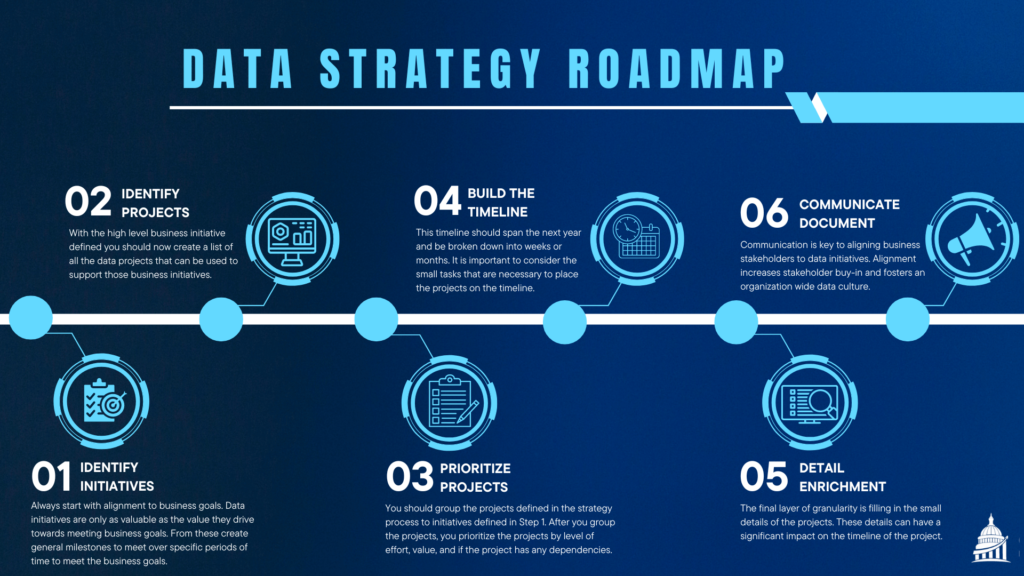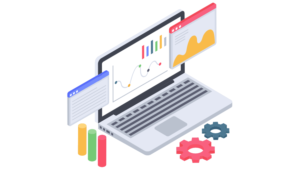Having a strategy is paramount to creating a data driven organization. A lack of data strategy is a major contributor poor returns on investment.
Read MoreData Strategy Roadmap
Data strategy is a data collection initiative that defines the goals of your business and the projects needed to meet those goals. As a part of the data strategy process a data roadmap is created to document the prioritization of projects. In this article you will learn the following:
- What is a data strategy roadmap? What is the purpose of the roadmap?
- When should you build/revisit a data strategy roadmap?
- How do you create a data strategy roadmap?
What is a data strategy roadmap? what is the purpose of a roadmap?
A roadmap is a document within the data strategy that identifies projects and timelines to deliver on business goals. Projects within the roadmap should align with business goals. The roadmap prioritizes data initiatives based on impact and level of effort. Roadmaps also provide milestones to measure progress against.
Who uses a data strategy? how is data strategy used?
Data strategy is defined in a document which serves as an organization’s North Star. This document contains the plan, schedule, and outcomes for the data strategy. This document is shared across the organization to provide clarity, increase buy-in, and communicate the business value being driven by the data team.
A good roadmap should tackle these problem areas:
- Value: Roadmaps are results driven. Data initiatives in the roadmap should have a clear impact on a business goal and should be stated through a clear metric.
- Commitment: Roadmaps have the buy-in of the entire organization. Stakeholders should have input into the strategy process and creation of the roadmap. This helps to build the data culture in the organization.
- Trust: With clear value shown and commitment from the stakeholders, the roadmap will increase the trust in the plan to build data initiatives.
A good roadmap answers the following questions:
- Why: Why is the project being built. What specific business value does the project provide?
- What: What projects need to be built to achieve the business milestones?
- When: When do the projects need to be built to deliver on business milestones?
When should you build/revisit a data strategy roadmap?
First, if you do not currently have a roadmap, you need to get one built asap. Building data initiatives without a roadmap is like driving a ship without a rudder. Sure you are going somewhere, but it might not be where you want to go.
Once you have a roadmap, you should update it regularly and when your organization is making significant changes. Regularly can mean different things for each company. However, we recommend revisiting your roadmap at least quarterly. This helps to update assumptions made in the strategy phase, communicate to the team the value being driven by the data initiatives, and track progress made on milestones.
Significant changes in the company should lead to revisiting the roadmap to find if new data initiatives are needed to meet business goals. These significant changes include:
- Entering new markets: Are projects needed to map the characteristics of these new markets? What insights do you need to make a market entry successful?
- Changes to company structure: New projects may be needed to support new business groups or to optimize existing processes.
- Changes in industry compliance: Changes in data collection practices due to regulation may impact projects.
- Launching new products: Consider if new projects are needed to identify product features or potential bundling with current products.
HOW DO YOU CREATE A DATA STRATEGY ROADMAP?
To build a data strategy roadmap you should work from a high level down to more granular details. You can do this by following this six step process.

Step 1: Identify Initiatives
Always start with alignment to business goals. Data initiatives are only as valuable as the value they drive towards meeting business goals. From these create general milestones to meet over specific periods of time to meet the business goals. Some questions to consider are:
- What are the company’s goals over the next year? 3 years?
- Are there significant changes to the business that need to be taken into account?
- Where is our current data maturity vs where it needs to be?
Step 2: Identify Projects
With the high level business initiative defined you should now create a list of all the data projects that can be used to support those business initiatives. This list does not need to include every detail of the project, that will be defined in a later step.
Step 3: Prioritize Projects
You should group the projects defined in the strategy process to initiatives defined in Step 1. After you group the projects, you prioritize the projects by level of effort, value, and if the project has any dependencies. Determining priorities allows you to:
- Set realistic expectations to stakeholders
- Identify risks and mitigate those risks
- Allocate the resources necessary to meet business goals
- Identify quick wins to deliver value quickly
Step 4: Build the Timeline
With the projects prioritized it is time to slot the projects into specific dates on the calendar. This timeline should span the next year and be broken down into weeks or months. It is important to consider the small tasks that are necessary to place the projects on the timeline. These small tasks include project requirement building with stakeholders, implementation of new tools, acquiring new data, and hiring new team members.
Step 5: Detail Enrichment
The final layer of granularity is filling in the small details of the projects. These details can have a significant impact on the timeline of the project. These details should be added to each project on the timeline:
- The people and resources necessary to complete the project. Make sure that the team members and the resources will be available to work on the project.
- Any dependencies that need to be completed before the project can be completed. Oftentimes these dependencies are related to the correct data being available to complete the project. Make sure that you have the correct data in place.
- Defining the key stakeholders that will be using the project. Identifying key stakeholders allows you to include them in the project process which increases stakeholder buy-in.
- The estimated time and budget to complete the project.
Step 6: Create & Communicate the Roadmap
Communication is key to aligning business stakeholders to data initiatives. Alignment increases stakeholder buy-in and fosters an organization wide data culture. Effective communication includes the following:
- Share the Roadmap across the organization to show the business value that will be provided by the data initiatives.
- Clearly communicate the milestones that the projects in the Roadmap will achieve.
- Provide updates on the progress of milestones and project timelines. Show how the value assumed is achieved after project completion.
Related Articles We Think You Would Enjoy Next
Beyond Basic Books: How Tableau Dashboards Enhance QuickBooks Data
QBO reports leave a lot to be desired. How can Tableau fix this?
Read MoreA Data Analytics Approach to Optimal Warehouse Coverage
Data analytics helps warehouse operators be data driven. Find out how.
Read MoreCDA provides Both strategic planning and the team to implement A Data analytics Strategy. book a call to build your data strategy.


